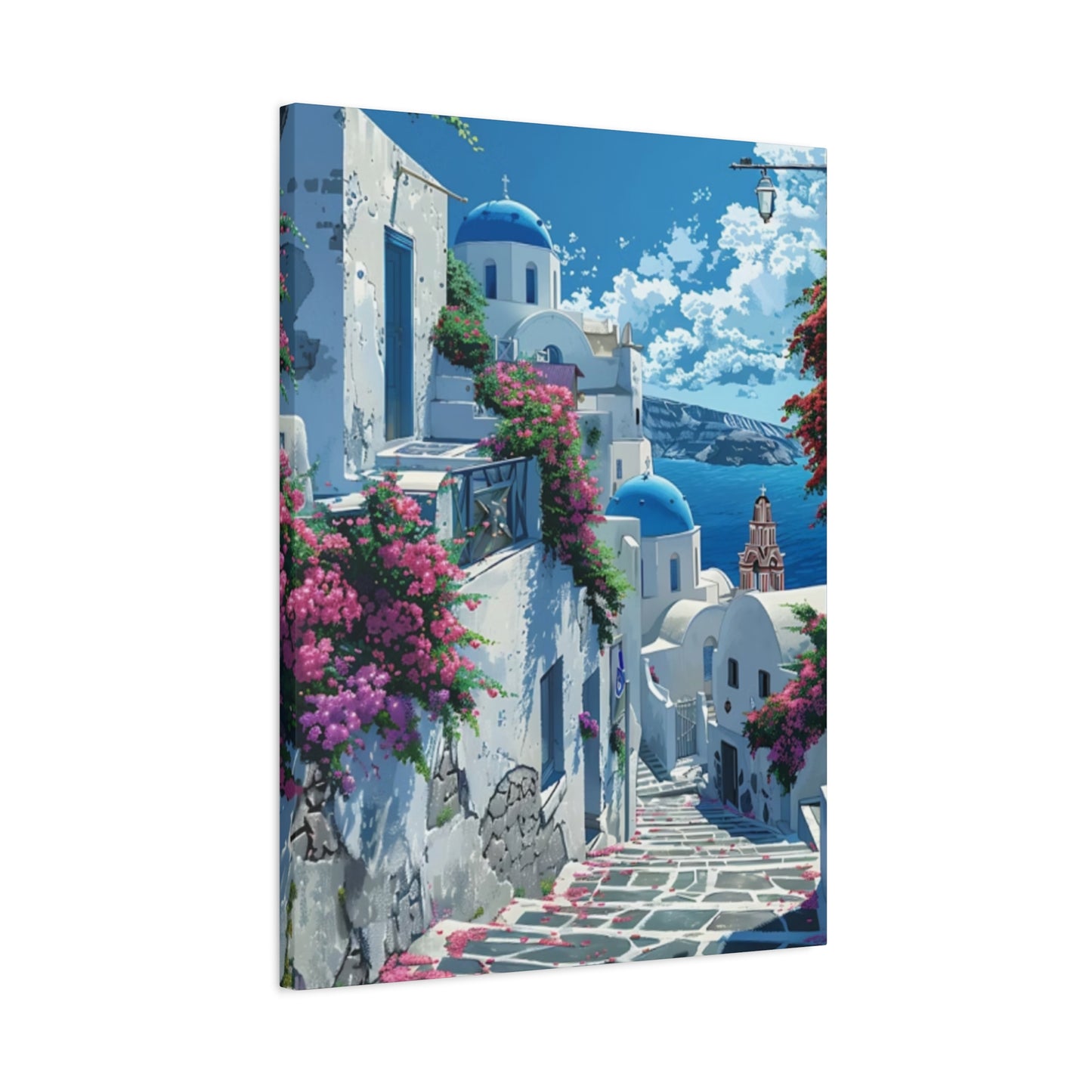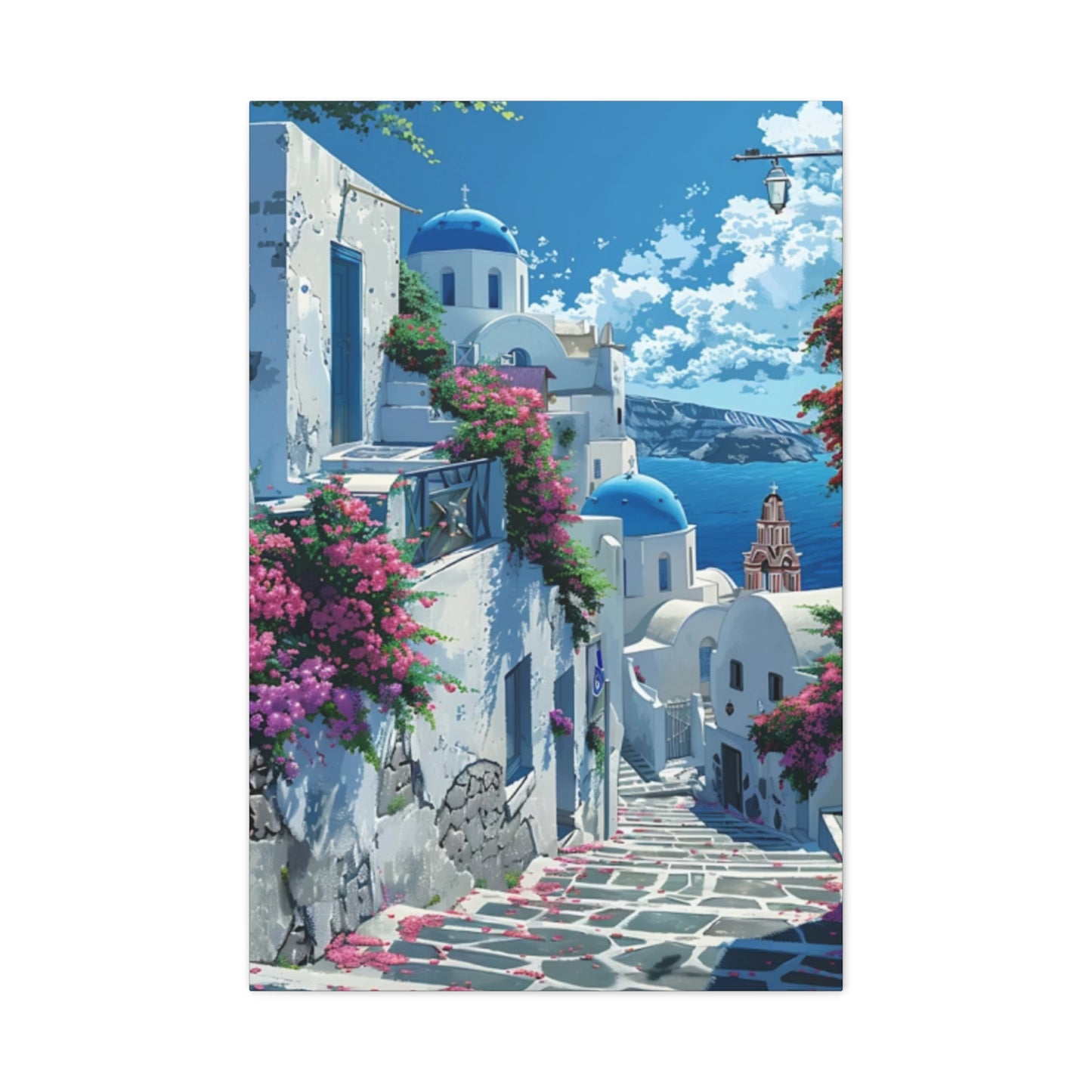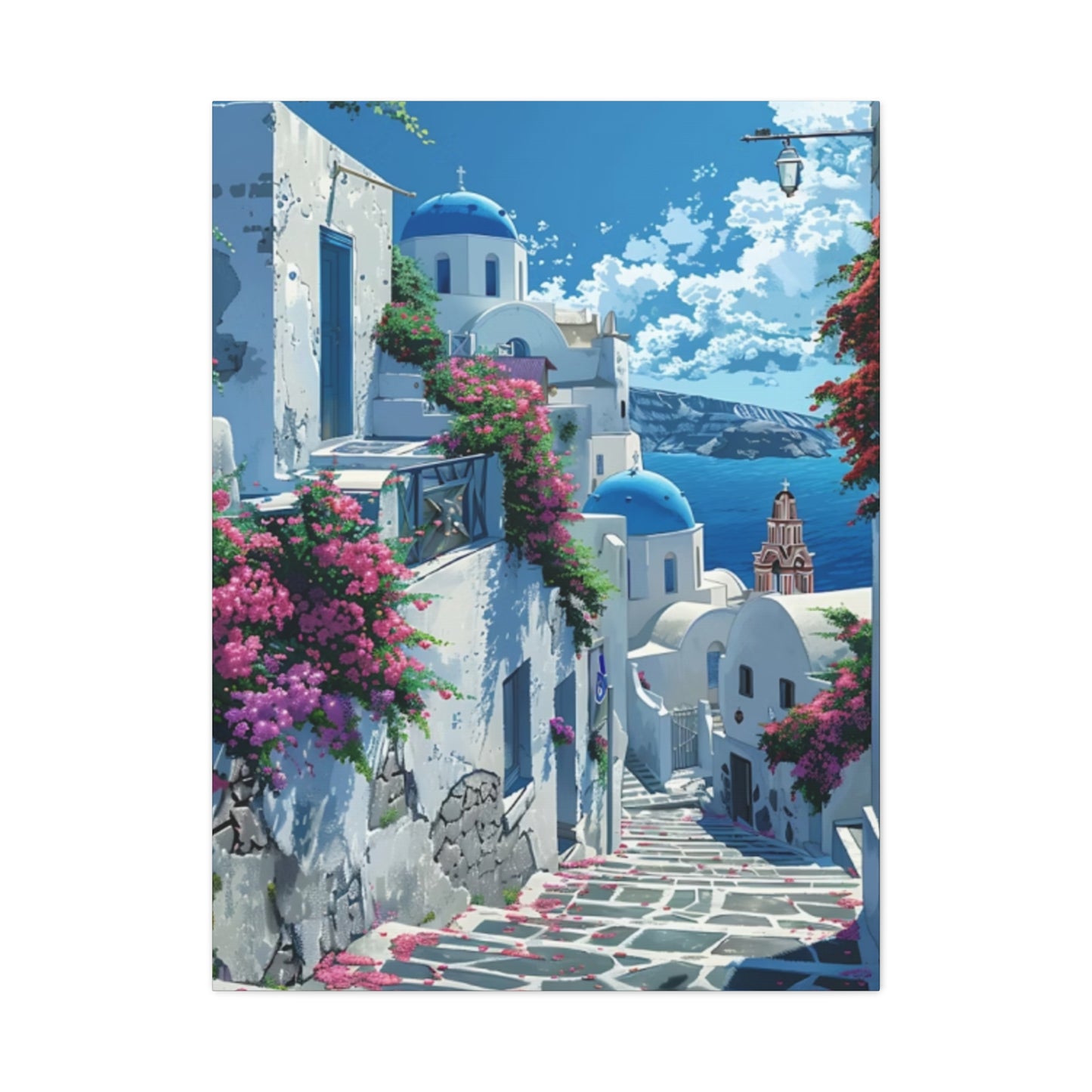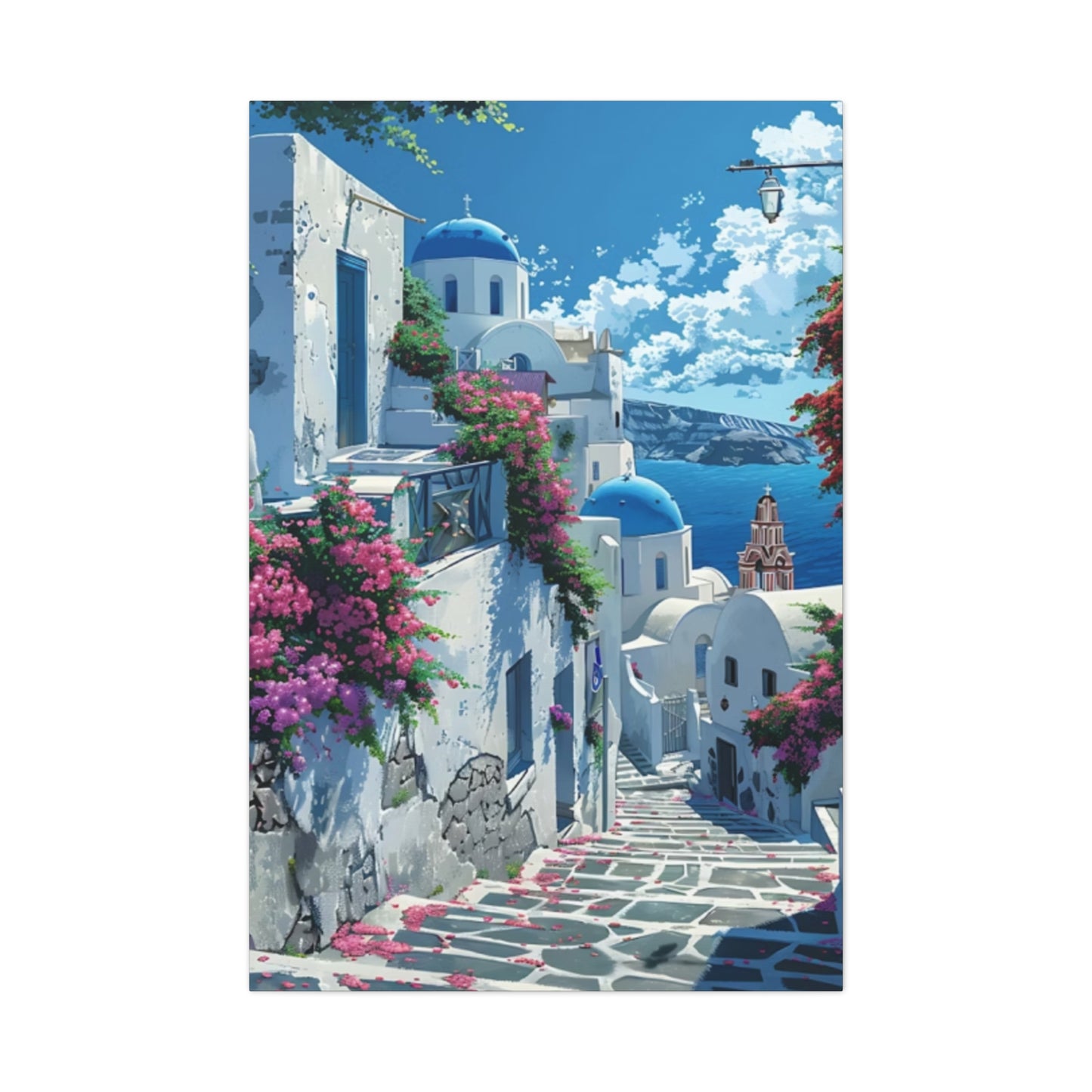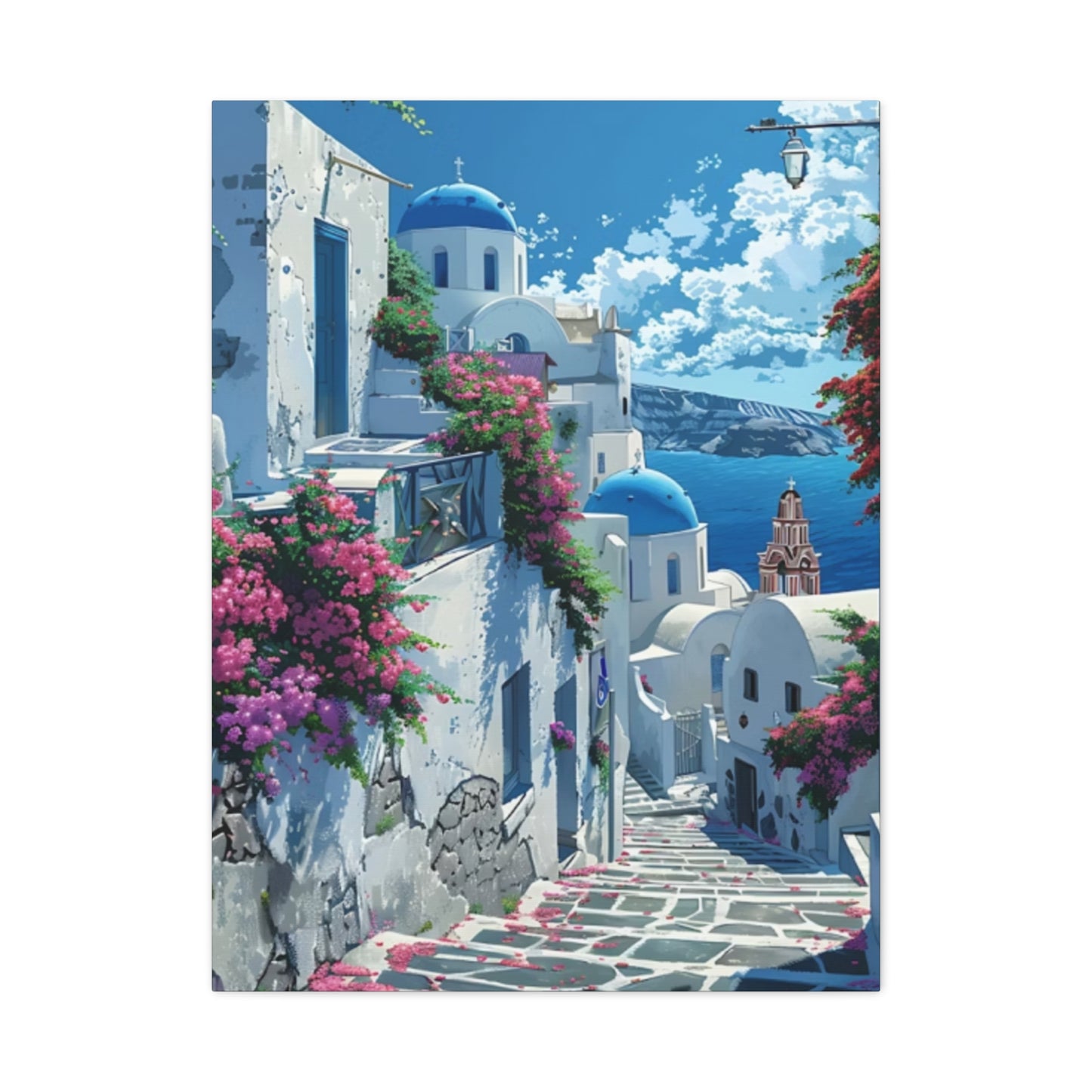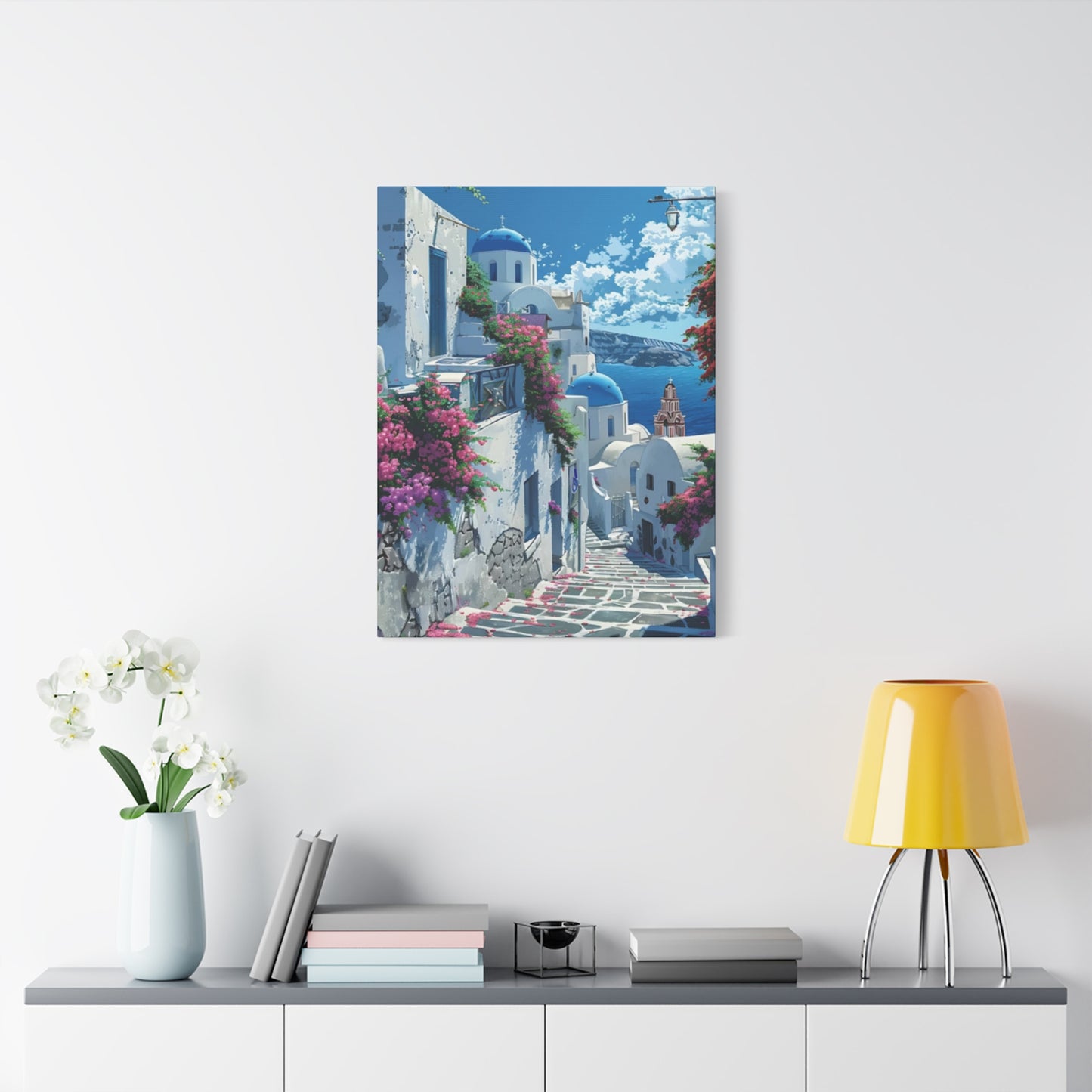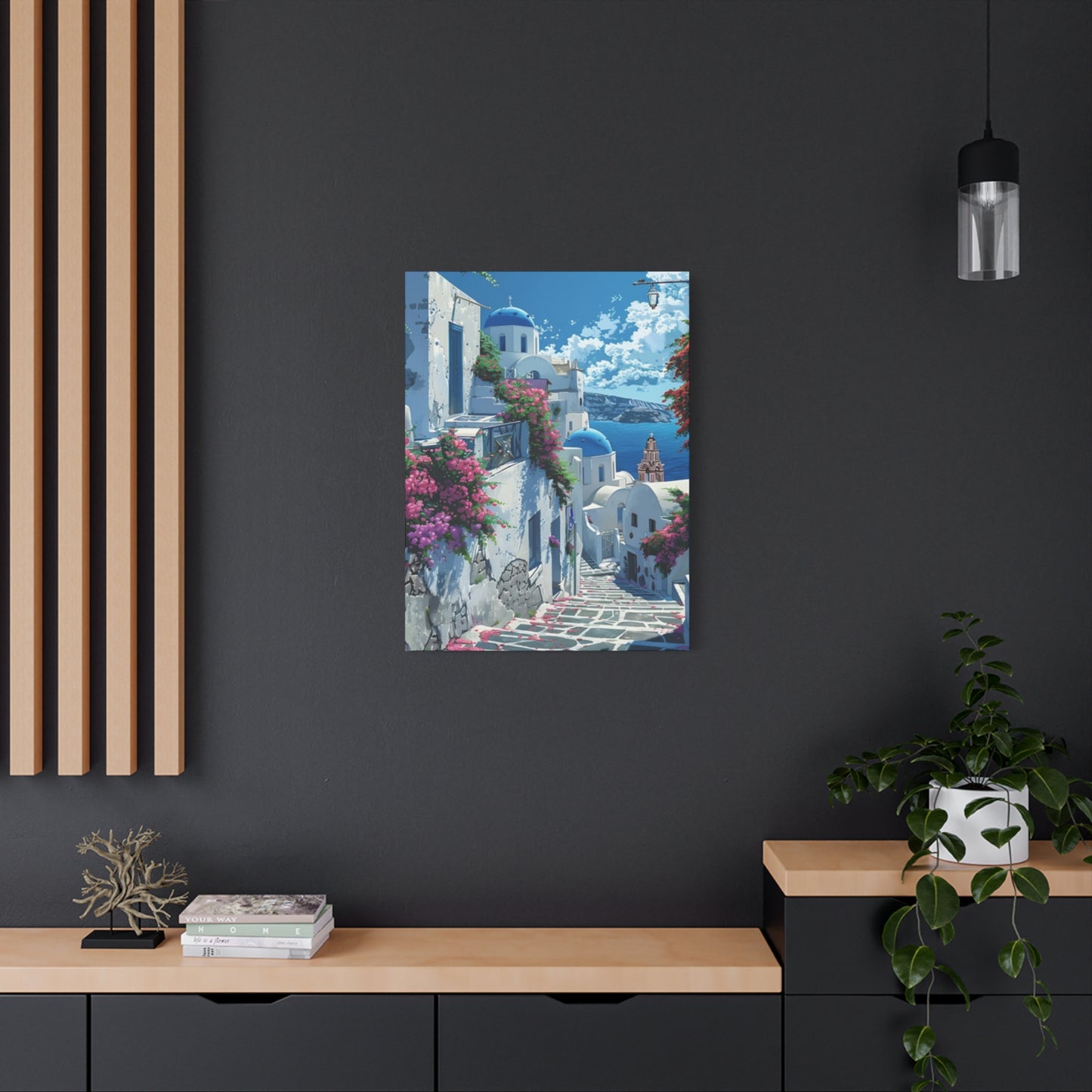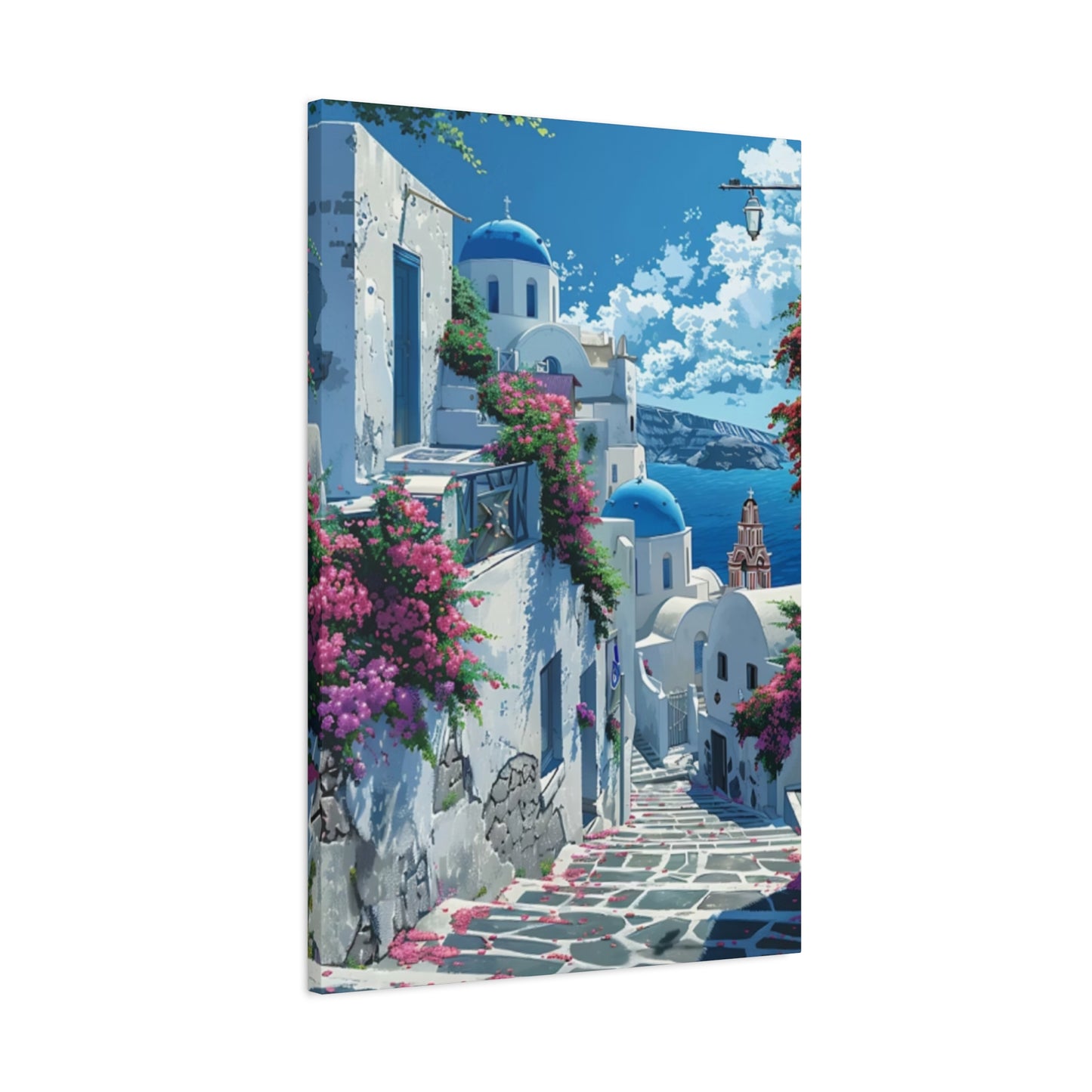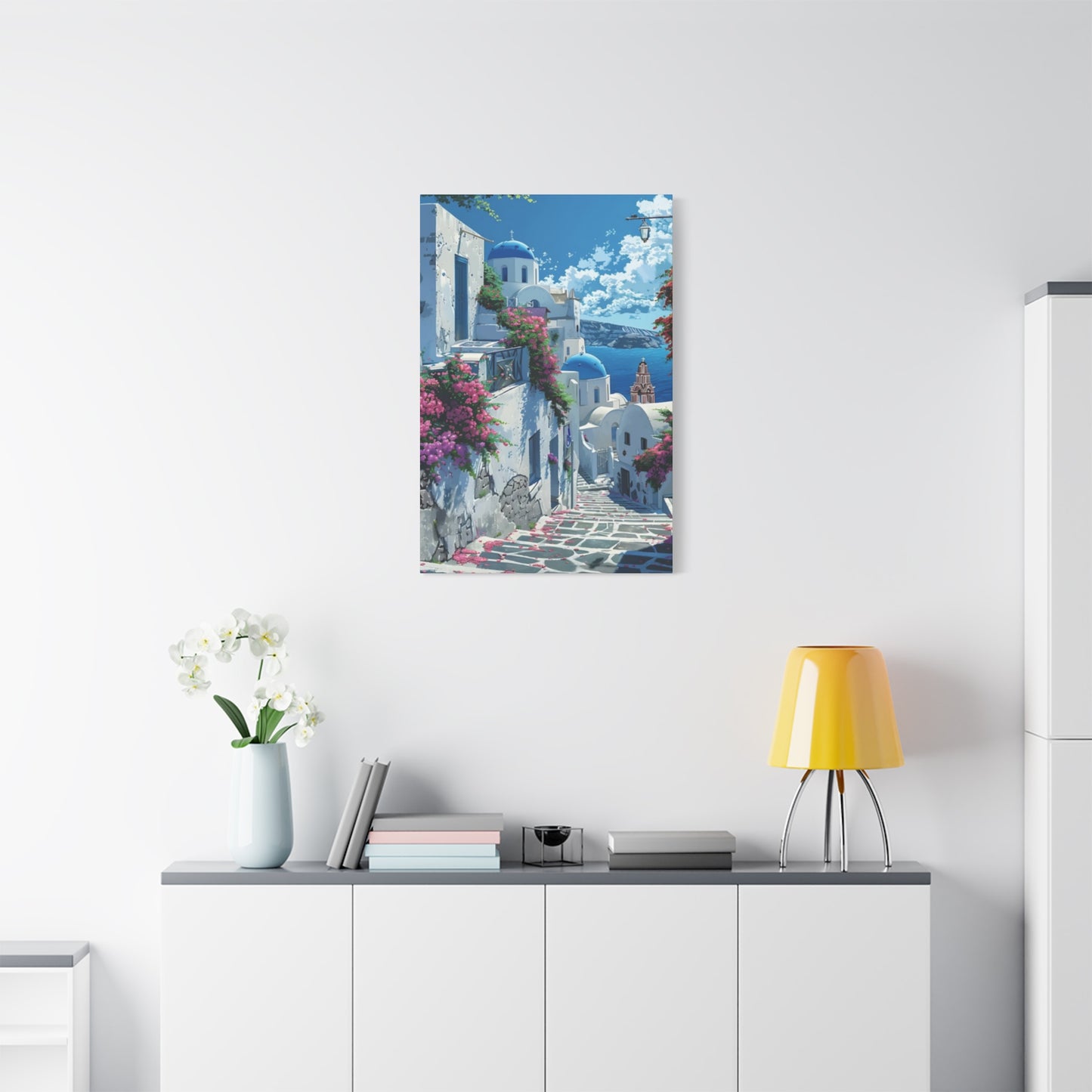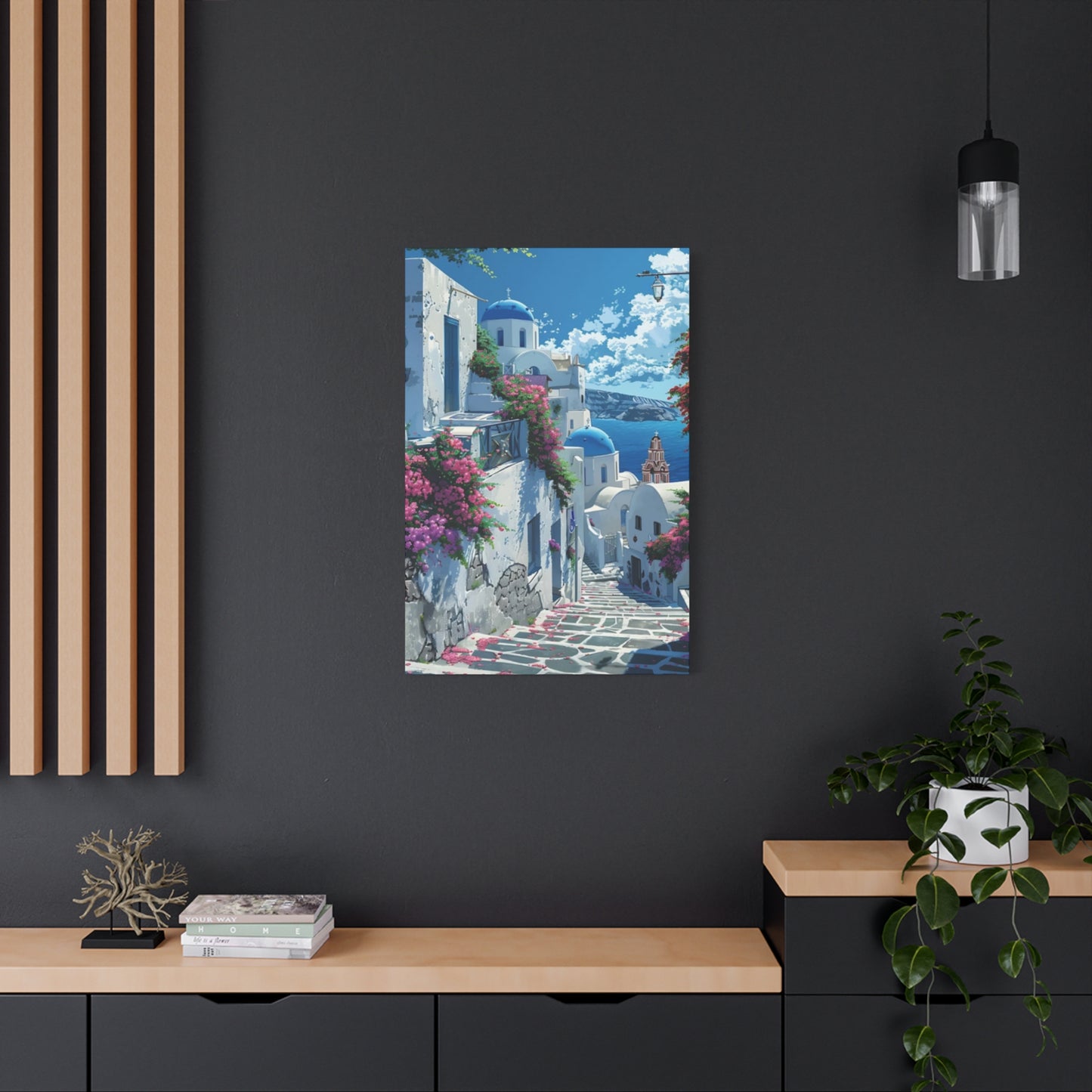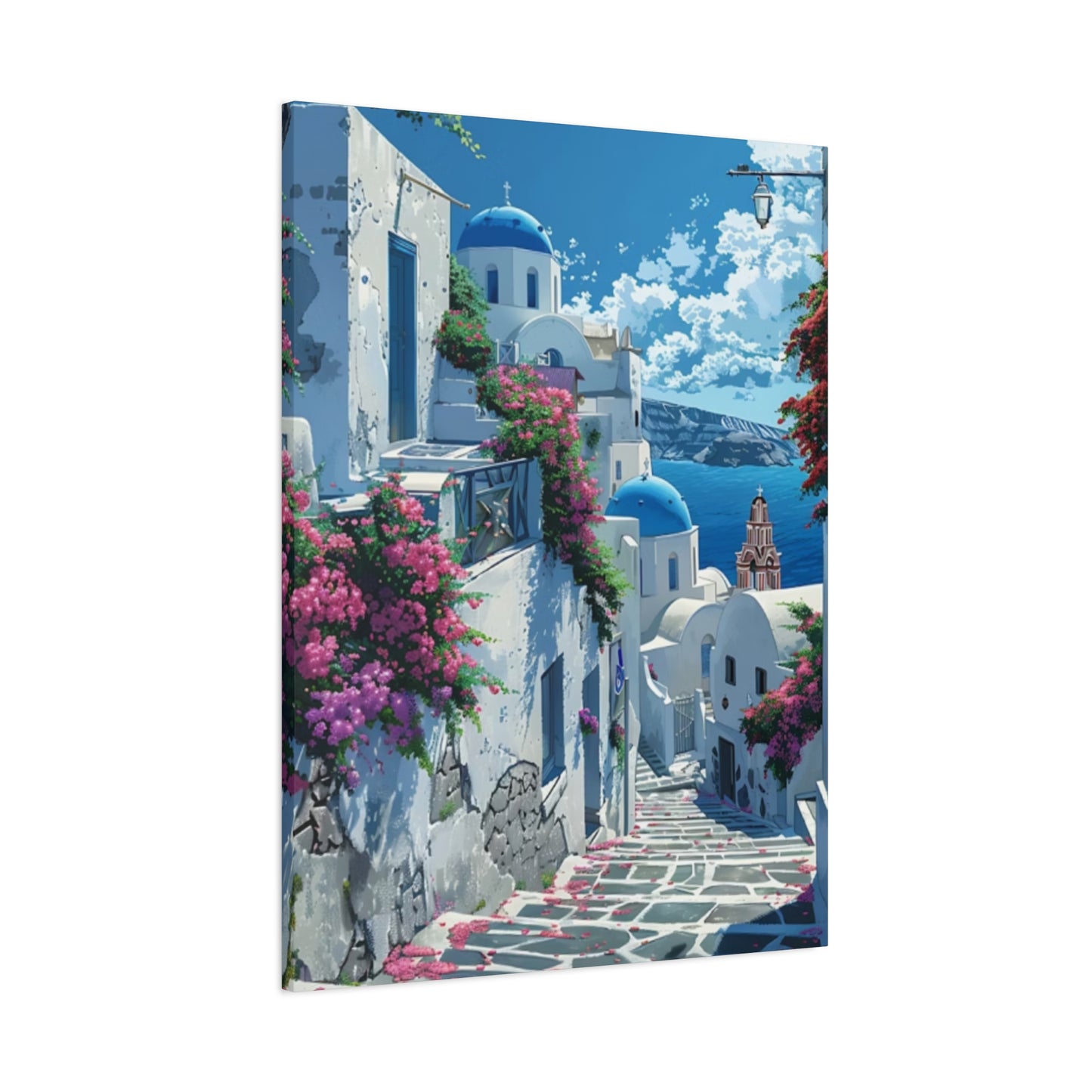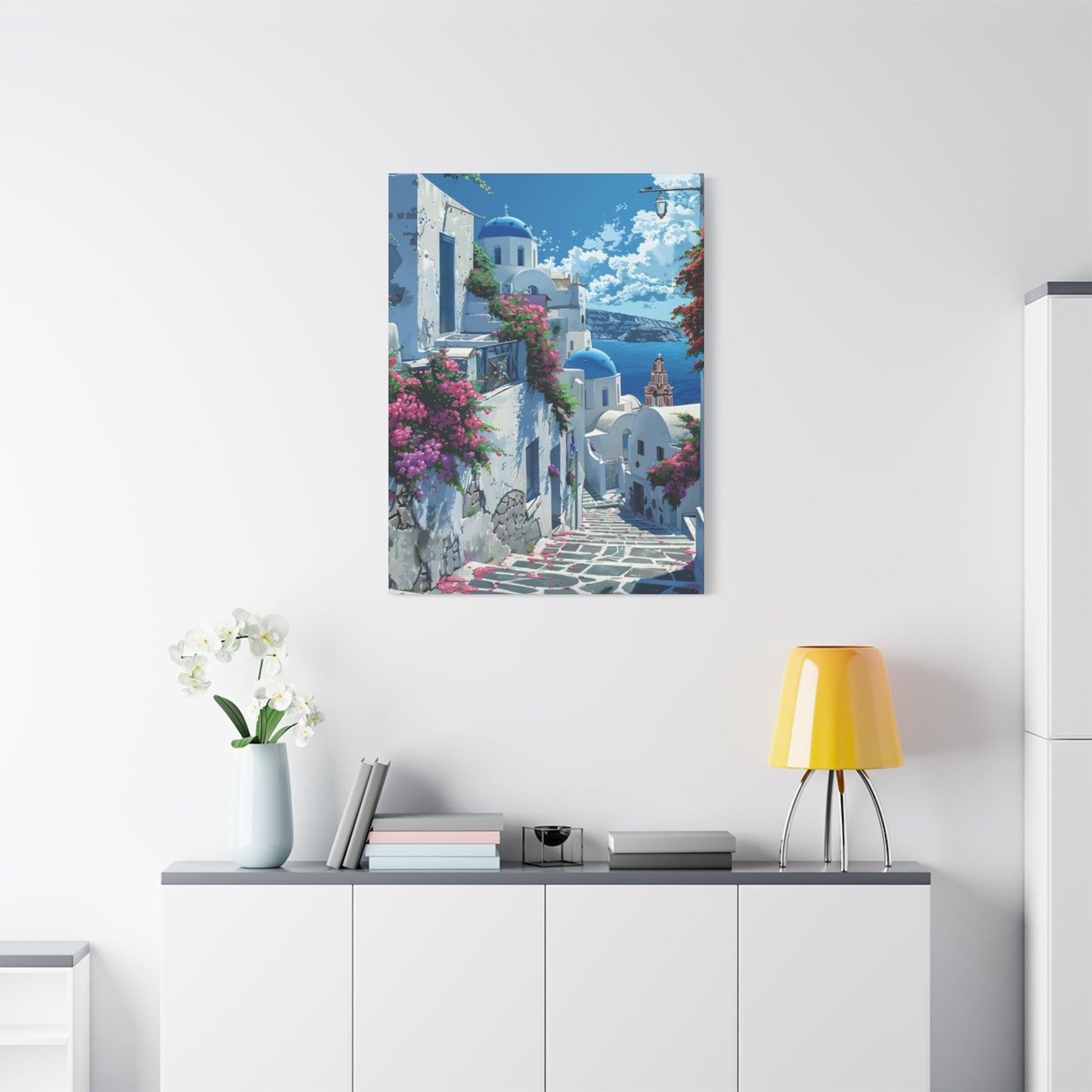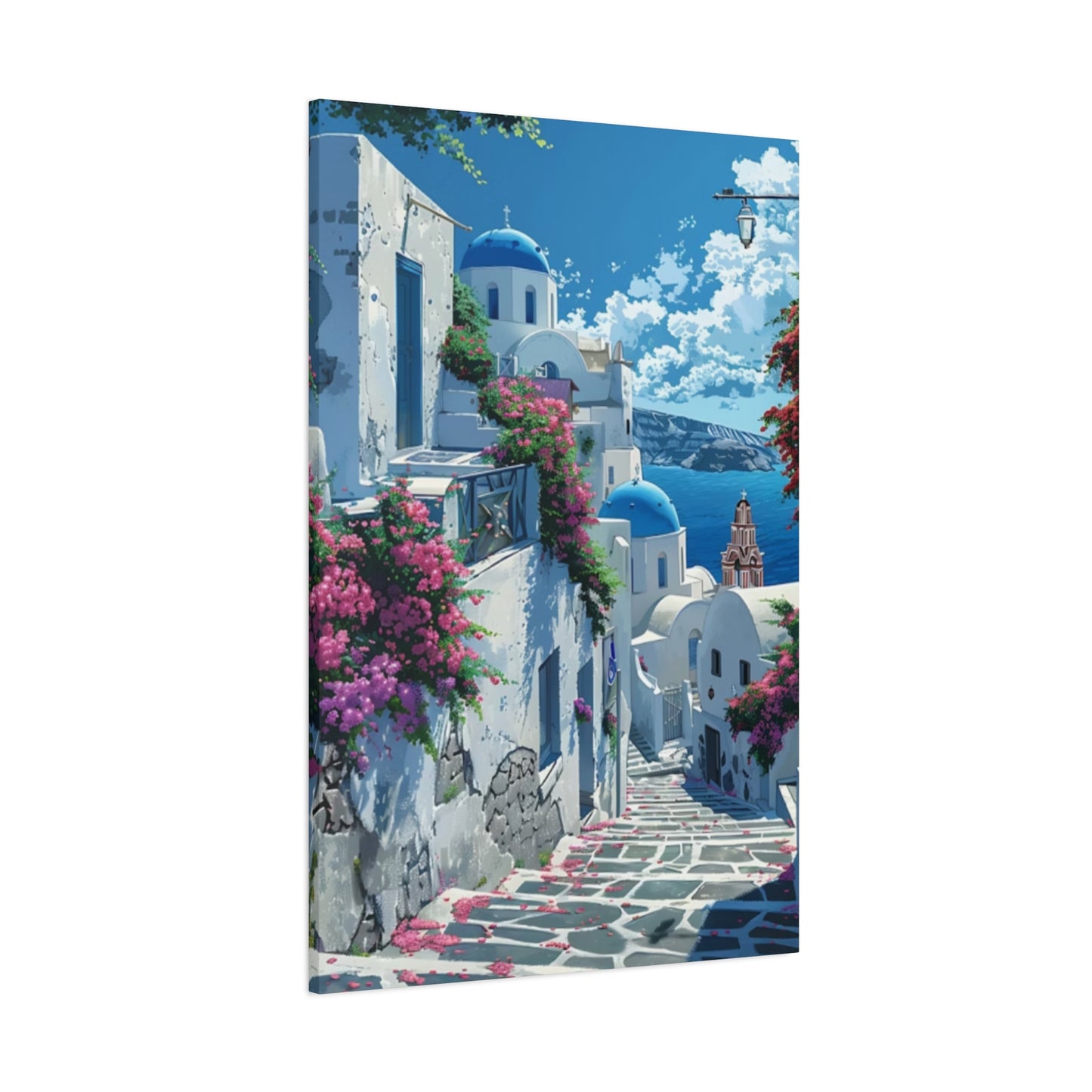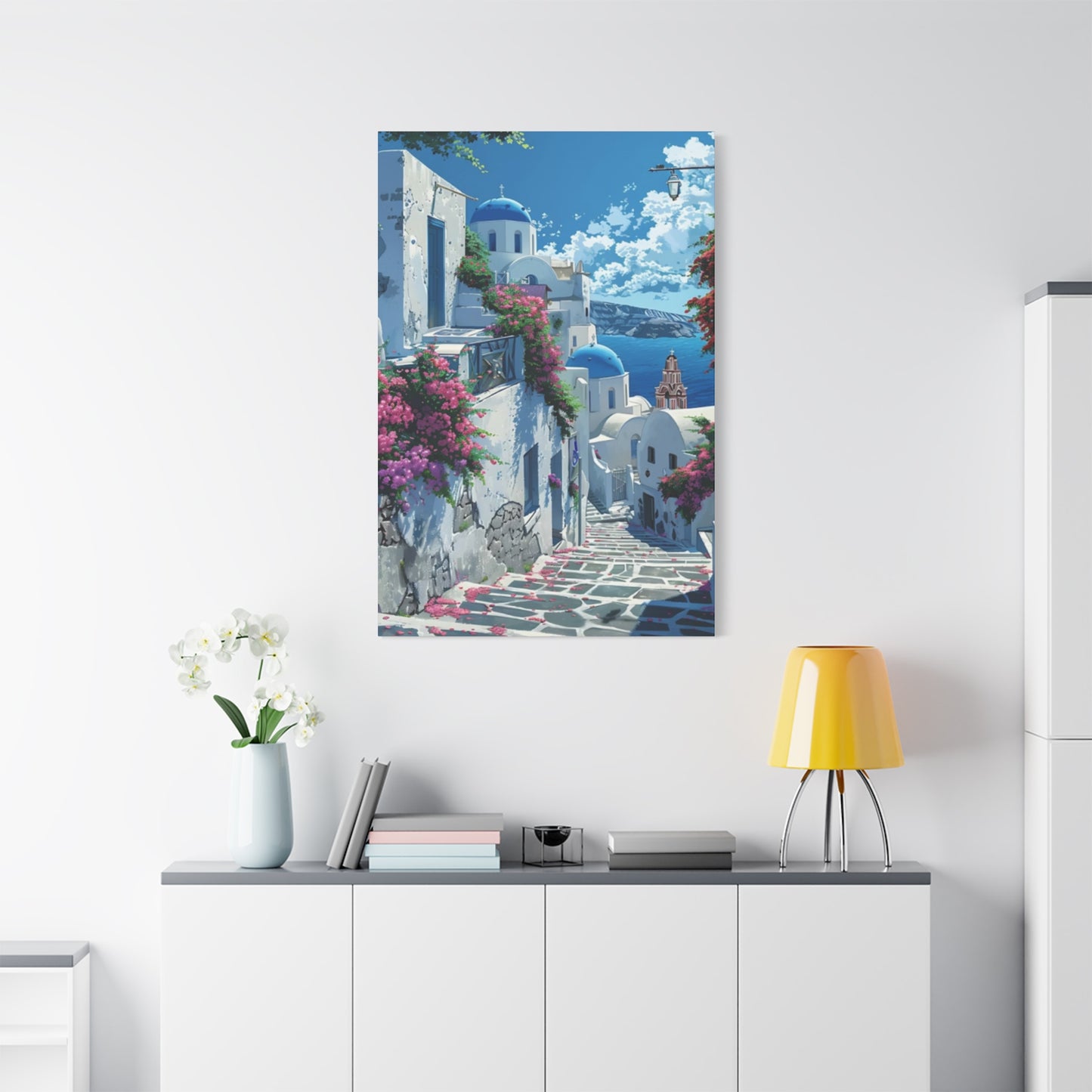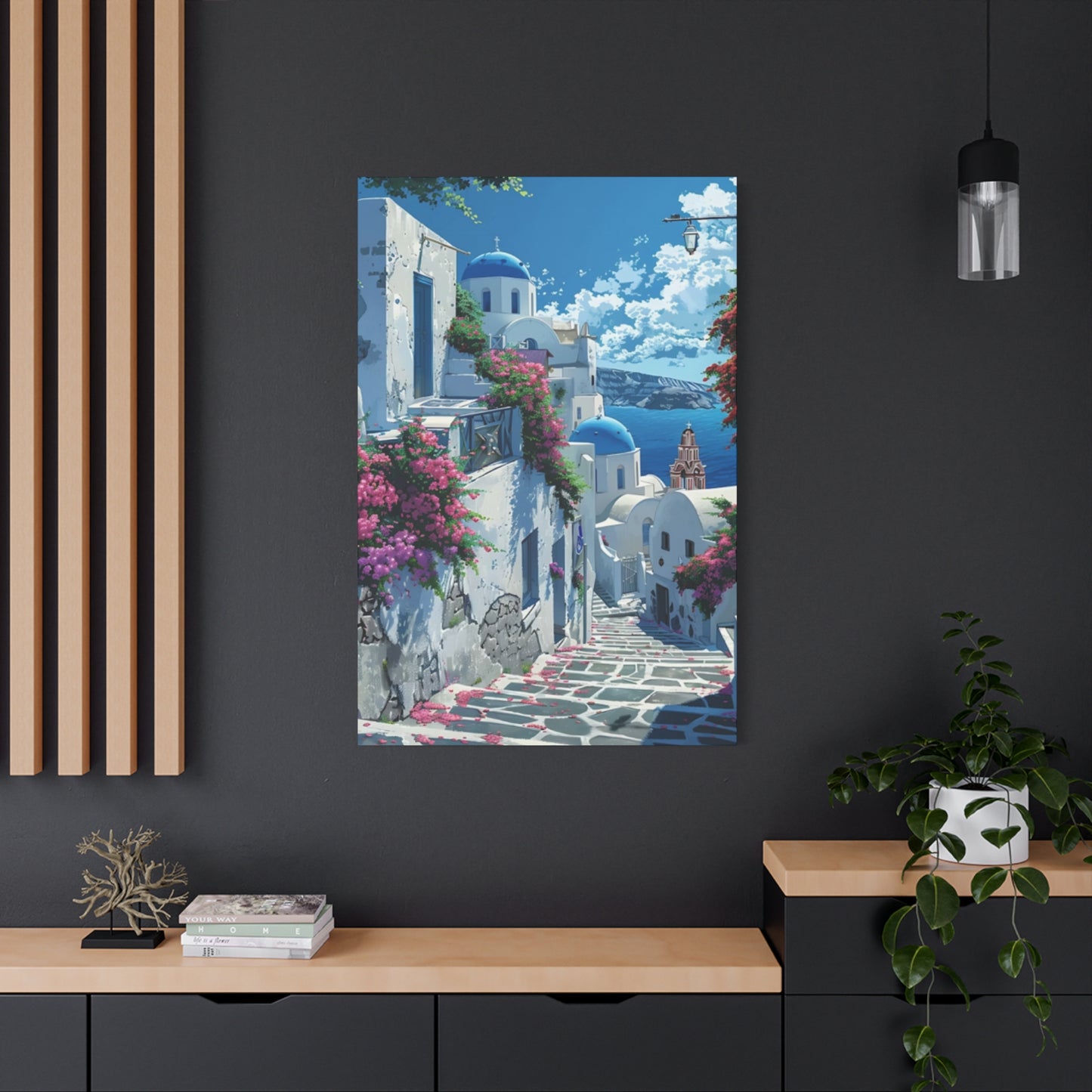Relive Your Greek Vacation: Streets of Greece Wall Art to Spark Memories
The allure of Mediterranean landscapes has captivated artists and collectors for centuries, with the picturesque pathways and coastal vistas of Greece standing among the most celebrated subjects. When seeking to infuse living environments with the warmth and character of Aegean charm, carefully selected artwork depicting Hellenic thoroughfares offers an authentic connection to this timeless region. These visual representations transport viewers to sun-drenched locales where azure skies meet whitewashed buildings, creating an atmosphere of perpetual vacation within residential and commercial settings alike.
The artistic interpretation of Greek pathways extends far beyond simple documentary photography or literal representations. Contemporary artists and traditional painters alike have found endless inspiration in the architectural elements, cultural textures, and atmospheric qualities that define these legendary locations. From the labyrinthine passages of island villages to the bustling commercial districts of ancient cities, each artistic rendering captures distinct moods and moments that resonate with viewers seeking authentic Mediterranean aesthetics.
Understanding the cultural significance and visual appeal of these artistic subjects enables collectors and decorators to make informed decisions when selecting pieces for their collections. The following comprehensive exploration examines various aspects of this artistic genre, from technical considerations in displaying such works to the emotional narratives they communicate. Whether approaching this subject as a seasoned collector or first-time purchaser, the depth of options available within this category provides opportunities for creating meaningful connections between artwork and environment.
Capturing Greek Street Life in Wall Art
The essence of Hellenic urban existence manifests through countless visual elements that artists strive to preserve on canvas and in prints. Morning light filtering through bougainvillea-draped pergolas, elderly residents conversing on weathered stone steps, and merchants arranging colorful produce outside family-owned shops all contribute to the authentic atmosphere that makes these scenes so compelling. Artists working in this genre must balance documentary accuracy with artistic interpretation, selecting which elements to emphasize and which to minimize for maximum visual impact.
Successful artistic representations of Greek thoroughfares typically incorporate human elements that suggest life and activity without overwhelming the architectural and natural components. A solitary figure ascending a steep stairway, a cat lounging in afternoon shade, or laundry hanging between buildings adds narrative dimension while maintaining focus on the environmental characteristics. These subtle inclusions transform static architectural studies into dynamic glimpses of daily existence, inviting viewers to imagine themselves within the scene rather than observing from distant remove.
The technical execution of such artwork varies tremendously across artistic movements and individual styles. Impressionistic approaches emphasize light quality and atmospheric effects through loose brushwork and suggested rather than delineated forms. Photorealistic renderings meticulously document every architectural detail and surface texture, appealing to viewers who appreciate technical precision. Contemporary mixed-media interpretations might incorporate collage elements, text fragments, or abstract passages that convey emotional responses to these locations rather than literal documentation.
Seasonal variations provide artists with dramatically different visual material even when depicting identical locations. Summer scenes burst with intense color saturation, harsh shadows, and brilliant sunlight that creates stark value contrasts. Spring representations feature blooming flora that softens architectural edges and introduces organic shapes among geometric building forms. Autumn and winter views, though less commonly depicted, offer subdued palettes and different lighting conditions that appeal to collectors seeking alternatives to typical Mediterranean imagery.
The relationship between foreground, middle ground, and background elements requires careful orchestration in compositionally successful works. Foreground interest might include detailed rendering of cobblestone patterns, potted plants, or architectural ornaments that draw viewers into the scene. Middle ground typically features the primary architectural subjects and any human or animal activity, while backgrounds establish context through distant buildings, mountain silhouettes, or glimpses of sea. This layering creates visual depth that enhances the immersive quality of the artwork.
Cultural authenticity remains paramount for artists seeking to create convincing representations rather than generic Mediterranean fantasies. Specific architectural details such as particular door styles, window configurations, chimney designs, and roofline treatments distinguish Greek construction from Italian, Spanish, or North African buildings. Artists who have spent extended periods observing and sketching in these locations naturally incorporate such details, while those working from reference materials must research carefully to avoid anachronistic or geographically inappropriate elements.
The emotional resonance of these artistic subjects extends beyond mere aesthetic appeal to touch deeper psychological responses. Research in environmental psychology suggests that images of pathways and passages activate neural pathways associated with exploration and discovery, triggering subtle excitement responses. The warm color palettes typical of these scenes promote feelings of comfort and security, while the architectural elements suggesting age and permanence provide psychological anchoring. These subconscious responses contribute significantly to the popularity of this artistic genre.
Contemporary digital technologies have expanded the possibilities for creating and reproducing Greek pathway imagery while raising questions about authenticity and artistic value. Digital paintings created entirely on tablets or computers can achieve effects impossible through traditional media, while high-resolution photography combined with digital manipulation allows for hybrid approaches. The printmaking industry now produces reproductions with color accuracy and detail resolution that rivals original paintings, democratizing access to this artwork category while challenging traditional notions of artistic originality.
Vibrant Colors of Greek Streets in Paintings
The chromatic richness characteristic of Hellenic village scenes provides artists with extraordinary opportunities for color exploration and emotional expression. The iconic combination of brilliant white architecture against deep blue accents forms the foundation of Greek color identity, yet this simplified palette represents merely the beginning of available chromatic possibilities. Bougainvillea cascading in magenta and fuchsia, terracotta roof tiles weathered to warm rust tones, and the subtle variations within whitewashed surfaces from cream to pale blue all contribute to complex color harmonies.
Artists approaching these subjects must make fundamental decisions about color saturation levels that significantly impact the emotional character of finished works. Highly saturated palettes emphasizing pure, intense hues create energetic, celebratory atmospheres that evoke vacation excitement and Mediterranean exuberance. More subdued approaches using desaturated or grayed versions of local colors produce contemplative, nostalgic moods that suggest quiet mornings or fading afternoon light. Neither approach claims superiority; rather, each serves different aesthetic preferences and decorative contexts.
The challenge of accurately representing brilliant Mediterranean sunlight has occupied painters since ancient times. The intensity of light in Greek latitudes during summer months creates luminosity that appears almost supernatural to viewers from northern regions. Artists must exaggerate value contrasts and employ unexpected color combinations to suggest this quality convincingly. Shadows shift from expected grays and browns into purples, blues, and even greens where reflected light bounces between surfaces, creating optical complexity that demands sophisticated color mixing skills.
Complementary color relationships appear naturally throughout Greek village environments, providing ready-made compositional strategies for artists. The blue and orange pairing manifests in doors and shutters against sunlit walls, while purple flowering plants contrast against yellow-toned stone. These naturally occurring complementary relationships create visual vibration and energy that holds viewer attention while maintaining aesthetic harmony. Skilled artists emphasize or modify these relationships according to their artistic intentions, sometimes pushing contrasts for dramatic effect or harmonizing them for subtlety.
Regional variations in traditional color preferences offer artists opportunities for specificity and authenticity. Cycladic island architecture typically features the archetypal white and blue combination, while Crete exhibits more earth tones and colorful door treatments. Dodecanese buildings often incorporate yellow and ochre tones, and mainland villages display greater variety reflecting diverse cultural influences. Artists familiar with these regional distinctions can signal specific locations through color choices, adding layers of meaning for knowledgeable viewers while maintaining general appeal.
The psychological impact of color choices extends beyond mere aesthetic preference into physiological responses. Warm colors—reds, oranges, yellows—increase heart rate and energy levels, creating stimulating environments when featured prominently in artwork. Cool colors—blues, greens, purples—produce calming effects that lower blood pressure and promote relaxation. The typical Greek village scene balances warm sunlit surfaces against cool shadows and blue elements, creating psychologically balanced compositions that feel simultaneously energizing and peaceful.
Contemporary color theory applications allow artists to manipulate viewer responses through strategic chromatic decisions. Analogous color schemes using adjacent hues create harmonious, cohesive compositions that feel unified and peaceful. Triadic schemes employing three equidistant colors produce dynamic, balanced arrangements with built-in variety. Split-complementary approaches offer contrast without the intensity of direct complementary pairings. Artists well-versed in these theoretical frameworks can consciously design color relationships that achieve specific atmospheric and emotional goals.
The technical challenges of color reproduction in prints and canvas transfers require careful attention during production processes. Digital printing technologies have advanced tremendously, yet subtle color shifts sometimes occur between original paintings and reproductions. Quality producers calibrate equipment meticulously, use archival inks with extended color gamuts, and perform color matching under controlled lighting conditions. Collectors should evaluate samples under lighting conditions similar to intended display locations, as illumination quality dramatically affects color perception.
Iconic Landmarks in Streets of Greece Art
Recognizable architectural and environmental features provide immediate geographical context while serving as compositional focal points in Hellenic thoroughfare artwork. The characteristic windmills of Mykonos, with their cylindrical white towers and triangular thatched caps, appear frequently in artistic representations of that island's charm. These structures provide vertical elements that break horizontal architectural rhythms while symbolizing the intersection of traditional functionality and contemporary tourism culture. Artists position them variously as dominant subjects or supporting elements depending on compositional intentions.
The stepped pathways that characterize many island villages offer dramatic compositional opportunities through linear perspective and rhythmic repetition. Staircases ascending hillsides create natural leading lines that draw viewer attention upward through compositions while suggesting journey and exploration themes. The interplay of light and shadow across stair treads produces abstract geometric patterns that add visual interest beyond representational content. Artists emphasize these elements through exaggerated perspective, selective lighting, or color treatments that transform functional architecture into aesthetic subjects.
Distinctive doorways throughout Greek villages function as cultural signatures and focal points within artistic compositions. Traditional door designs vary by region but often feature arched tops, divided panels, and hardware with historical significance. The practice of painting doors in bright colors—turquoise, cobalt, emerald, crimson—against white walls creates natural focal points that draw attention and suggest the human presence behind architectural facades. Artists frequently compose scenes around single doorways that become metaphors for welcome, mystery, or transition between public and private realms.
Chapel domes rising above village rooflines provide instantly recognizable silhouettes that signal Greek identity to viewers worldwide. The characteristic blue dome topped with a simple cross appears across the Cycladic islands with minor variations that distinguish individual structures. Artists incorporate these elements to establish cultural context while providing curved forms that contrast effectively against predominantly rectilinear architecture. The symbolic significance of religious structures adds spiritual dimensions to ostensibly secular streetscape compositions.
Coastal elements visible from elevated village pathways expand compositional possibilities while reinforcing geographical identity. Glimpses of sapphire sea between buildings, distant islands on horizons, or harbors far below provide spatial depth and environmental context. These elements also introduce cool color notes that balance warm architectural tones while suggesting the maritime culture underlying Greek civilization. Artists control the prominence of these features, sometimes reducing them to minimal suggestions or elevating them to co-equal status with architectural subjects.
Ancient columns, archways, and ruins incorporated into later architecture demonstrate the historical continuity that distinguishes Greek villages from more recent settlements. A Hellenistic column fragment serving as a decorative element in a wall, Byzantine architectural details surviving in medieval churches, or classical stonework repurposed in contemporary buildings all tell stories of layered history. Artists sensitive to these elements communicate cultural depth beyond superficial prettiness, appealing to viewers who appreciate historical consciousness in their artistic acquisitions.
The characteristic Mediterranean vegetation that thrives throughout Greek villages adds organic contrast to geometric architecture while providing seasonal variation. Olive trees with their silvery foliage, cypress trees punctuating skylines like dark exclamation points, and grapevines trained across pergolas all appear frequently in artistic representations. These botanical elements soften architectural severity while connecting human settlements to agricultural traditions that sustained these communities through millennia. Artists employ them variously for compositional purposes, cultural authenticity, and symbolic resonance.
Contemporary additions to traditional villages present artists with aesthetic challenges regarding authenticity and artistic license. Satellite dishes, power lines, modern signage, and parked vehicles intrude on idealized visions of timeless Mediterranean existence. Some artists meticulously edit such elements from their compositions, creating romanticized versions that match viewer expectations. Others embrace contemporary anachronisms as honest documentation of living communities that evolve alongside tradition. Collectors should consider which approach aligns with their aesthetic preferences and decorative intentions.
Using Streets of Greece Prints for Warm Decor
Incorporating Hellenic thoroughfare imagery into residential and commercial environments requires strategic thinking about scale, placement, and relationship to surrounding design elements. These artworks carry inherent warmth through their characteristic color palettes, lighting qualities, and cultural associations, making them particularly effective for creating welcoming atmospheres in various settings. The psychological comfort evoked by Mediterranean architectural imagery stems partly from the universal appeal of human-scaled, pedestrian-oriented environments that contrast with contemporary automobile-dominated urban planning.
Living areas benefit tremendously from the introduction of Greek pathway imagery that reinforces relaxation and leisure associations. Above seating arrangements, these artworks create visual focal points that anchor furniture groupings while contributing atmospheric qualities conducive to conversation and entertainment. The warm color palette typical of such imagery complements natural materials like wood, stone, and textiles in earth tones, creating cohesive design schemes that feel organic rather than contrived. The nostalgic quality of these scenes encourages viewers to slow down and appreciate present moments rather than rushing toward future obligations.
Dining environments gain particular advantage from Greek thoroughfare artwork that evokes the leisurely meal culture characteristic of Mediterranean societies. Images suggesting outdoor cafes, tavernas, or village squares where communal dining occurs naturally reinforce the social bonding that occurs around shared meals. The appetite-stimulating properties of warm colors in these images subtly enhance dining experiences while creating conversation starting points for guests. Restaurants and hospitality venues frequently employ such imagery to establish cultural authenticity and differentiate their brands within competitive markets.
Bedroom applications of Greek pathway imagery should emphasize tranquil interpretations rather than energetic compositions to support restful atmospheres. Sunset or twilight scenes featuring subdued lighting and minimal activity promote relaxation and transition toward sleep states. The nostalgic quality of such imagery can also inspire pleasant dream content by suggesting vacation memories or aspirational travel destinations. Collectors selecting artwork for sleeping areas should prioritize pieces with horizontal orientations and calming color temperatures that complement rather than stimulate psychological states.
Home offices and work environments benefit from Greek thoroughfare imagery that provides mental escape valves during demanding tasks. The suggestion of elsewhere—particularly pleasant, vacation-associated locations—offers psychological relief during stressful work periods without completely disrupting concentration. The cultural association of Greece with philosophy, learning, and intellectual achievement adds symbolic reinforcement for knowledge work. However, images should avoid excessive detail or visual complexity that might prove distracting during tasks requiring sustained attention.
Commercial environments ranging from travel agencies to medical offices employ Greek pathway imagery to establish atmospheric qualities aligned with brand identities and customer expectations. Travel-related businesses obviously benefit from imagery that inspires wanderlust and suggests exotic destinations. Healthcare providers use such artwork to create calming environments that reduce patient anxiety. Retail establishments targeting customers seeking lifestyle aspirations find that Mediterranean imagery communicates quality, sophistication, and attention to aesthetic detail. The versatility of this artistic category makes it adaptable to diverse commercial applications.
The relationship between artwork and lighting design significantly impacts the effectiveness of Greek thoroughfare imagery in achieving desired atmospheric effects. Natural daylight enhances the authenticity of scenes depicting bright Mediterranean sunshine, while artificial lighting requires careful color temperature selection to avoid distortion. Picture lights or accent lighting focused on artwork creates gallery-like presentation that elevates perceived value and importance. Conversely, ambient lighting that washes over artwork without emphasis creates more casual, residential feelings. Lighting decisions should align with overall design intentions and the specific qualities of selected artworks.
Seasonal rotation of displayed artwork allows collectors to emphasize different aspects of their collections while refreshing environmental aesthetics. Summer months might feature bright, energetic Greek pathway scenes that celebrate warm weather, while autumn and winter benefit from more subdued interpretations that feel appropriate to changing seasons. This practice prevents aesthetic fatigue from prolonged exposure to identical imagery while maximizing the utility of entire collections. Storage and rotation logistics require planning but offer significant returns in sustained appreciation and environmental variety.
The Charm of Narrow Alleys in Greek Wall Art
The confined passageways that characterize traditional Greek villages hold particular aesthetic and emotional appeal that distinguishes them from broader thoroughfares or open squares. These intimate passages create sense of discovery and exploration, inviting viewers to imagine what lies around corners or beyond visible limits. The architectural compression that defines narrow alleys produces exaggerated perspective effects where parallel walls converge dramatically toward vanishing points, creating dynamic compositions with inherent visual tension and forward movement.
The vertical emphasis of narrow alley compositions contrasts effectively with the horizontal orientation predominant in landscape art, offering collectors opportunities for diverse display arrangements. Vertical artworks complement tall, narrow wall sections between windows, beside doorways, or in hallway settings where horizontal pieces prove impractical. The upward movement suggested by steep, narrow passages creates energizing effects that make such pieces particularly effective in circulation areas where people move through rather than settle. The psychological lift provided by upward-directed compositions can positively influence mood and energy levels in high-traffic domestic areas.
Light behavior in confined passageways provides artists with dramatic chiaroscuro opportunities that create striking value contrasts and atmospheric effects. Narrow openings to the sky produce concentrated shafts of light that illuminate specific architectural details while leaving surrounding elements in shadow. This selective illumination creates natural spotlighting effects that guide viewer attention while producing abstract patterns through the interplay of light and shadow. Artists emphasizing these qualities create compositions with strong graphic impact that remains visually compelling even in small reproduction formats.
The increased proximity to architectural details in narrow alley settings allows artists to showcase decorative elements that might disappear in broader views. Wrought iron window grilles, carved door panels, decorative tile work, and weathered plaster textures become prominent compositional features rather than incidental details. This close-range perspective appeals to viewers who appreciate craftsmanship and historical authenticity, providing visual interest that rewards extended observation. The intimate scale of such subjects also creates psychological closeness that makes viewers feel they are experiencing rather than merely observing depicted locations.
The suggestion of hidden or private realms beyond public view adds narrative intrigue to narrow alley compositions that broader street scenes rarely achieve. Partially visible courtyards, curtained windows, and closed doors hint at domestic life occurring beyond viewer access, creating mystery and stimulating imagination. This quality appeals to fundamental human curiosity while respecting the boundary between public observation and private existence. Artists manipulating these elements create psychological tension between revelation and concealment that engages viewers beyond purely aesthetic appreciation.
The organic irregularity of traditional narrow passageways contrasts sharply with the geometric order of planned urban design, providing visual relief from the regularity that characterizes most contemporary environments. Walls that lean slightly off vertical, uneven paving stones, and asymmetrical compositions reflect historical construction methods and gradual evolution rather than single-moment planning. This imperfection appeals to viewers fatigued by the relentless perfection of modern design, offering visual authenticity that feels human-scaled and approachable rather than intimidating or alienating.
Narrow alley scenes particularly suit smaller print formats and intimate display contexts where large-scale landscape imagery would overwhelm available surfaces. Powder rooms, hallway niches, stairway landings, and similar compact areas benefit from appropriately scaled artwork that respects spatial limitations while providing visual interest. The content of narrow alley imagery reinforces rather than contradicts the compressed nature of such settings, creating harmonious relationships between art and architecture. Collectors with space constraints find that these subjects deliver authentic Greek atmosphere without requiring expansive wall areas.
The technical challenges of photographing or painting narrow alleys require specialized skills and equipment that distinguish successful artistic treatments from amateur efforts. Limited working distance for photographers necessitates wide-angle lenses that can introduce distortion requiring correction. Painters must manage extreme foreshortening and perspective compression while maintaining architectural believability. Artists who master these challenges create compelling compositions that transport viewers to these distinctive locations through technical excellence combined with aesthetic sensitivity.
Small vs Large Streets of Greece Canvas Prints
The dimension selection for canvas reproductions of Greek thoroughfare imagery significantly impacts both aesthetic presentation and practical installation considerations. Small-format prints ranging from eight-by-ten inches to sixteen-by-twenty inches offer affordability, flexibility, and ease of installation that makes them ideal for experimental decorating or budget-conscious collecting. These modest dimensions suit intimate viewing distances and compact display areas while allowing for gallery wall arrangements that combine multiple pieces into larger compositional statements. The lower financial commitment of smaller prints enables collectors to explore various artistic styles and subjects before investing in larger pieces.
Medium-sized prints spanning twenty-by-thirty inches to thirty-by-forty inches represent the most popular category for residential display, balancing visual impact with manageable scale and reasonable pricing. These dimensions provide sufficient detail visibility from typical room viewing distances while remaining proportional to residential wall sections. A single medium-format print can anchor a wall arrangement or function as standalone artwork above furniture pieces. The moderate weight and size of these prints simplifies installation, typically requiring only standard picture hanging hardware without specialized mounting systems.
Large-format prints exceeding forty inches in either dimension create dramatic focal points that dominate architectural features and establish atmospheric character throughout entire rooms. These substantial pieces suit expansive wall areas in open-concept living spaces, commercial installations, or homes with generous ceiling heights where smaller artwork would disappear visually. The immersive quality of large prints allows viewers to appreciate fine details while experiencing the compositional grandeur that matches the scale of actual Greek thoroughfares. However, the significant cost, complex installation requirements, and visual dominance of large prints demand careful consideration before purchase.
The relationship between image complexity and print size affects optimal dimension selection for specific artworks. Highly detailed compositions with intricate architectural elements, rich textures, and complex lighting benefit from larger formats that allow viewers to appreciate artistic craftsmanship. Conversely, simpler compositions emphasizing bold shapes, limited color palettes, or graphic elements remain effective in smaller formats without loss of impact. Collectors should evaluate how specific images translate across size ranges, as some gain power through enlargement while others lose focus or become monotonous.
Viewing distance calculations help determine appropriate print dimensions for specific installation locations. The general guideline suggests that comfortable viewing distance equals approximately one-and-one-half times the diagonal measurement of the artwork. A thirty-by-forty inch print with a fifty-inch diagonal thus ideally requires seventy-five inches—roughly six feet—of viewing distance. Rooms or hallways with limited depth between walls may not accommodate large prints effectively, while spacious areas with distant viewing points demand larger formats to maintain visual presence. Measuring intended installation locations before purchase prevents scale miscalculations.
Gallery wall arrangements allow collectors to combine multiple smaller prints into composite displays that achieve the visual impact of larger single pieces while offering greater compositional flexibility. This approach enables thematic groupings exploring variations of similar subjects or curated collections representing diverse Greek locations and artistic styles. The irregular boundaries and internal variety of gallery walls create dynamic, personalized displays that reflect collector preferences more thoroughly than single images. However, successful gallery wall composition requires careful planning regarding spacing, alignment, and visual balance among dissimilar elements.
The technical quality of canvas printing varies significantly between small and large formats, with larger prints revealing production shortcomings more readily than compact versions. Resolution limitations become apparent in large prints if source images lack sufficient pixel dimensions, resulting in visible pixelation or softness that compromises perceived quality. Color consistency and ink coverage sometimes suffer in large-format production, particularly with bargain providers using inferior equipment and materials. Collectors investing in substantial prints should verify that producers use high-resolution source files, professional-grade printers, and archival materials appropriate to the format.
Budget considerations naturally influence size selection, with costs increasing geometrically rather than arithmetically with dimension expansion. A thirty-by-forty inch print typically costs three to four times the price of a sixteen-by-twenty inch version of identical imagery due to increased material costs, longer production times, and greater shipping expenses. Collectors must balance the enhanced impact of larger formats against budget realities, sometimes choosing to invest in fewer large statement pieces rather than numerous smaller works. The long-term satisfaction and decorative impact of appropriately sized artwork generally justifies premium pricing for formats that suit specific applications.
Framing Ideas for Greek Street Scene Art
The presentation framework surrounding canvas prints or paper reproductions dramatically influences their aesthetic impact and integration within broader decorative schemes. Traditional wood frames in natural finishes or warm stains complement the organic Mediterranean character of Greek thoroughfare imagery while providing substantial physical presence that elevates perceived artwork value. Oak, walnut, or pine frames with visible grain patterns echo the natural materials prominent in traditional Greek architecture, creating harmonious relationships between content and presentation. The dimensional depth of wood moldings casts subtle shadows that add three-dimensional interest to wall surfaces.
Contemporary floating frame systems that leave narrow gaps between artwork edges and frame elements create clean, modern presentations that suit minimalist interiors without competing against artwork for attention. These systems work particularly effectively with canvas prints, allowing the thickness of stretched canvas to become visible as a design element. The shadow gap produced by floating frames adds dimensionality while maintaining focus on image content rather than decorative framing. This approach appeals to collectors favoring uncluttered aesthetics who wish to emphasize artwork rather than its presentation apparatus.
Metal frames in matte black, brushed silver, or champagne gold finishes provide sleek, sophisticated presentations that complement contemporary and transitional design schemes. The narrow profiles typical of metal frames minimize visual distraction while providing necessary structural support and protective functions. Black metal frames create strong graphic contrast against white or light-colored walls, establishing clear boundaries that focus attention. Silver and gold tones introduce subtle decorative elements that can coordinate with hardware finishes, lighting fixtures, or accent accessories throughout rooms.
Mediterranean-inspired frames incorporating blue accents or distressed finishes create thematic unity between frame and content while reinforcing cultural associations. Frames painted in shades matching the characteristic doors and shutters of Greek villages establish immediate visual connection between presentation and subject. Distressed finishes suggesting age and weathering echo the patina of historical architecture depicted within frames. This approach works particularly well in settings embracing coastal or Mediterranean decorative themes where consistent stylistic elements throughout spaces create cohesive atmospheres.
Matting treatments for paper prints provide opportunities for color coordination and compositional adjustment while offering physical protection for artwork surfaces. Wide mats in cream, warm white, or subtle earth tones create breathing room around images while adding perceived value through generous presentation. Colored mats can pull accent colors from images to create sophisticated color relationships, though this technique requires careful restraint to avoid overwhelming artwork or creating dated appearances. Double-matting with narrow inner mats in contrasting colors adds depth and complexity to presentations while allowing for creative color play.
Frameless presentations using stand-off mounting hardware create ultra-contemporary displays that emphasize image content through elimination of traditional framing elements. Acrylic panels mounted inches from walls via metal posts create floating effects while providing surface protection. This approach suits commercial installations, gallery-style residential displays, or contemporary loft environments where industrial aesthetics predominate. The technical complexity and cost of these systems limits their residential application, though the dramatic visual impact justifies premium pricing for collectors seeking distinctive presentations.
Custom framing provides opportunities for precise coordination with existing decor while ensuring proper materials and techniques for long-term preservation. Professional framers advise on appropriate matting, glazing, and mounting methods that protect artwork from environmental damage while creating presentations aligned with aesthetic preferences and budgets. The cost premium of custom framing over ready-made alternatives varies dramatically but generally returns value through superior materials, precise fitting, and preservation-quality construction. Collectors investing in significant artwork should prioritize custom framing that protects investments while creating presentation worthy of the artistic content.
The relationship between frame style and artwork era or style requires careful consideration to avoid anachronistic pairings that diminish effectiveness of both elements. Traditional oil paintings of Greek scenes typically suit substantial wooden frames with classical profiles that match the formal artistic approach. Contemporary photographs or digital artworks pair effectively with minimal modern frames that respect sleek aesthetic sensibilities. Mixed approaches can succeed when deliberately employed for ironic or eclectic effects but generally work best when executed with sophisticated design awareness. Collectors uncertain about appropriate pairings benefit from consulting design professionals who can evaluate specific combinations objectively.
Combining Blue and White in Greek Wall Art
The archetypal color pairing associated with Greek island architecture provides artists and decorators with a visually powerful combination grounded in both cultural authenticity and color theory principles. The stark contrast between brilliant white walls and deep blue accents creates graphic impact that remains legible and compelling across vast viewing distances and varied lighting conditions. This combination satisfies fundamental human preferences for clarity and order while evoking specific geographical and cultural associations that add layers of meaning beyond purely formal aesthetic considerations.
The symbolic significance of blue and white within Greek culture extends beyond mere decorative preference into national identity and spiritual symbolism. The Greek flag's blue and white stripes reflect the combination's status as a national identifier, while Orthodox churches prominently feature blue domes as sacred markers. The purification associations of white combine with the heavenly and maritime symbolism of blue to create meaning that resonates both consciously and subconsciously with viewers. Artists incorporating these colors access cultural narratives that enrich artistic content beyond surface appearances.
The technical challenge of rendering convincing white surfaces occupies significant attention in Greek thoroughfare painting, as pure white rarely appears in nature or architecture despite initial impressions. Successful artists employ subtle tinting with warm or cool undertones, introduce reflected colors from surrounding elements, and modulate values across surfaces to suggest three-dimensional form rather than flat graphic shapes. The interplay between bright highlights in full sun, subtle mid-tones in ambient light, and deeper values in shadows creates luminous whites that appear brilliant without loss of form or texture.
Blue accent elements provide crucial compositional functions beyond their obvious decorative appeal within Greek thoroughfare artwork. Doors, shutters, window frames, and furniture painted in various blue shades create focal points that organize visual hierarchy and guide viewer attention through compositions. The cool temperature of blue provides psychological and chromatic relief from warm architectural tones, preventing monotony while creating balanced color relationships. The cultural expectation of blue accents means their presence confirms authenticity while their absence or variation signals artistic liberty or regional specificity.
The range of blue hues appearing across Greek architecture offers artists considerable variation within the general blue and white paradigm. Pale sky blues create subtle, sophisticated palettes that feel calmer and more refined than intense cobalt or azure shades. Deeper navy and ultramarine blues provide dramatic contrast and graphic punch suitable for bold compositional statements. Turquoise and aqua tones introduce green undertones that bridge between cool blues and warmer yellow-greens of Mediterranean vegetation. Artists select specific blue variants to establish particular moods and align with personal aesthetic preferences or representational accuracy.
Contemporary interior design applications of Greek blue and white imagery require consideration of existing color schemes and the risk of overwhelming neutral environments with strongly colored artwork. The graphic intensity of high-contrast blue and white compositions can dominate rooms decorated in subtle earth tones or monochromatic schemes. Collectors might seek artworks incorporating additional colors—ochre, terracotta, green—that bridge between artwork and surrounding decor. Alternatively, embracing the contrast and allowing artwork to function as primary color source creates bold design statements that establish room character.
The psychological effects of blue and white combinations align well with the relaxation and escapism associations that make Greek thoroughfare imagery appealing for residential and commercial applications. Blue's documented calming properties reduce anxiety and promote peaceful mental states, while white's associations with cleanliness and simplicity create uncluttered psychological environments. Together, these colors suggest the clarity and renewal associated with vacation experiences, making such imagery particularly effective in bedrooms, bathrooms, and other private retreats where restoration and relaxation are primary functions.
Photographic versus painted approaches to blue and white subjects produce markedly different aesthetic results despite depicting identical architectural elements. Photography typically captures actual color relationships with documentary accuracy, including the subtle variations and imperfections inherent in real materials. Painting allows artists to purify, intensify, or stylize colors according to artistic vision, creating idealized versions that may feel more graphically powerful but less physically authentic. Neither approach claims inherent superiority, though collectors should recognize these distinctions when selecting pieces based on aesthetic preferences for realism versus interpretation.
Stories Told Through Streets of Greece Paintings
Narrative content embedded within Greek thoroughfare artwork extends beyond literal documentation of architectural features to communicate human experiences, cultural traditions, and universal themes through visual metaphors and symbolic elements. The pathway itself functions as a fundamental narrative device suggesting journey, transition, and forward progress toward unseen destinations. Artists employ perspective to create psychological movement through compositions, inviting viewers to imagine themselves walking through depicted scenes and discovering what lies beyond visible boundaries.
The presence or absence of human figures within compositions dramatically affects narrative interpretation and viewer relationships with depicted scenes. Solitary figures ascending staircases or walking away from viewers suggest contemplation, pilgrimage, or personal journey themes that invite identification. Multiple figures engaged in conversation or activity communicate community, connection, and daily life continuation despite tourism's transformative effects. Unpopulated scenes create contemplative stillness that allows viewers to project their own narratives onto empty stages, becoming protagonists within imagined scenarios.
Architectural details function as narrative clues revealing historical layering and cultural evolution within Greek villages. A classical column fragment incorporated into a medieval wall speaks to millennia of continuous habitation and repurposing of materials. Byzantine architectural elements surviving in later structures demonstrate religious continuity through political upheavals. Contemporary additions like electrical wiring or satellite dishes document ongoing adaptation of ancient settlements to modern life. Artists choosing which temporal layers to emphasize guide viewer interpretation toward historical consciousness or timeless idealization.
Seasonal and diurnal indicators within compositions communicate temporal specificity that affects narrative interpretation and emotional resonance. Morning light suggests beginnings, fresh starts, and awakening energy appropriate to hopeful narratives. Afternoon sun creates drama through strong shadows while implying peak activity and full engagement with life. Evening and twilight scenes introduce melancholy, reflection, and day's end contemplation. Seasonal markers through vegetation, light quality, or atmospheric conditions place narratives within annual cycles that connect human activity to natural rhythms.
The relationship between public pathways and private doorways creates narrative tension between revelation and concealment that engages viewer imagination. Partially open doors invite speculation about who might emerge or what activities occur within unseen interiors. Closed doors maintain privacy boundaries while suggesting hidden stories that remain inaccessible. Window glimpses into domestic scenes provide limited access that both satisfies and frustrates curiosity. Artists manipulating these elements between transparency and opacity control narrative openness and the degree of viewer participation required for meaning construction.
Cultural activities suggested through incidental details communicate authentic daily life beyond tourist-oriented presentations. Laundry hanging between buildings signals domestic routines and practical necessity rather than aesthetic staging. Fishing nets, agricultural implements, or work-worn tools document livelihoods sustained through physical labor. Chairs arranged for conversation or food preparation visible through windows reveal social and domestic patterns specific to Mediterranean culture. These narrative elements appeal to viewers seeking authentic cultural engagement rather than superficial exotic decoration.
The metaphorical potential of Greek thoroughfare imagery extends into philosophical and spiritual territories that transcend literal architectural documentation. Staircases ascending toward light symbolize spiritual aspiration and movement toward enlightenment across multiple religious and philosophical traditions. Labyrinthine passages through villages recall mythological narratives of journey and transformation. The meeting of earth, sea, and sky within single compositions speaks to elemental forces and human existence balanced between natural domains. Artists conscious of these symbolic layers create works that function simultaneously as documentation and meditation.
Contemporary narrative approaches sometimes incorporate text, collage, or mixed-media elements that make storytelling dimensions more explicit while risking heavy-handedness. Greek language fragments, philosophical quotations, or map elements can reinforce cultural authenticity when employed with restraint and aesthetic integration. Heavy-handed text additions or obvious symbolism can reduce sophisticated artwork to illustration or propaganda. The balance between suggestion and statement separates subtle artistic narrative from didactic messaging, with most sophisticated artists favoring implication over declaration.
Popular Greek Islands Featured in Wall Art
The Cycladic archipelago dominates artistic representations of Greek thoroughfare subjects due to the iconic white and blue aesthetic that has come to symbolize Greek islands universally. Santorini, particularly the villages of Oia and Fira perched on volcanic caldera cliffs, provides the most photographed and painted locations in Greece. The dramatic vertical geography, stunning sea vistas, and perfectly preserved traditional architecture create ready-made compositions that require minimal artistic manipulation. The concentration of tourism in Santorini means these images carry immediate recognition that appeals to travelers seeking souvenirs of personal experiences or aspirational travelers dreaming of future visits.
Mykonos contributes equally recognizable imagery through its distinctive windmills, waterfront tavernas, and maze-like village center filled with luxury boutiques and whitewashed passages. The island's reputation for sophisticated nightlife and celebrity visitors adds glamorous associations to artwork depicting its locations. The architectural preservation and pedestrian-only policies in Mykonos town create authentic village atmospheres despite heavy tourism, allowing artists to capture traditional scenes that remain visually valid despite contemporary commercial realities.
Conclusion
Reliving the magic of a Greek vacation is a deeply personal and enriching experience, and there is no better way to keep those memories alive than through Streets of Greece wall art. These captivating pieces do more than simply decorate a room—they transport you back to the sun-drenched alleys, vibrant marketplaces, and charming villages that define Greece’s unique character and allure. The beauty of this art lies in its ability to evoke emotions and memories, allowing you to revisit the places and moments that made your trip unforgettable, all from the comfort of your own home.
Greek streets are not just pathways—they are living tapestries woven with history, culture, and everyday life. From the narrow cobblestone lanes of Santorini to the bustling squares of Athens, these streets tell stories of ancient civilizations, lively traditions, and warm community spirit. Streets of Greece wall art captures these stories in vivid detail, showcasing iconic elements such as whitewashed houses with blue shutters, bougainvillea-draped balconies, quaint cafes, and the gentle rhythm of everyday life. This visual storytelling fosters a deep connection to the places you visited and invites you to reminisce about the smells, sounds, and atmosphere that made your vacation so special.
Moreover, this type of art offers a unique blend of nostalgia and inspiration. While the wall art sparks fond memories of past travels, it also ignites a sense of wanderlust and curiosity for future adventures. Each piece serves as a gentle reminder of the joy of exploration and the beauty of embracing new cultures. For those who haven’t yet experienced Greece firsthand, these artworks provide an inviting glimpse into the country’s charm and vibrancy, perhaps inspiring a future trip or simply fostering an appreciation for Greek culture.
Beyond its sentimental value, Streets of Greece wall art also enhances interior spaces with its warm colors, light-filled scenes, and timeless aesthetics. The soothing blues and whites, combined with earthy tones and vibrant floral accents, bring a sense of calm and Mediterranean sunshine into any room. This makes such art ideal for creating a tranquil, uplifting environment that reflects your personal journey and love for Greece. Whether displayed in a living room, hallway, or office, these pieces add character and a touch of elegance, serving as constant reminders of your travels and the joy they brought.
Furthermore, the popularity of Greek-inspired wall art underscores a broader trend toward celebrating travel and cultural experiences through home décor. In an increasingly globalized world, people are finding comfort and inspiration in surrounding themselves with meaningful visuals that tell stories beyond their immediate surroundings. Streets of Greece art taps into this desire for connection and memory preservation, offering an accessible and beautiful way to honor personal history and cultural heritage.
In conclusion, Streets of Greece wall art is much more than decorative imagery—it is a gateway to treasured memories, cultural appreciation, and future aspirations. By capturing the essence of Greece’s enchanting streets, this art invites you to relive the emotions, stories, and beauty of your vacation every day. It serves as a timeless tribute to the places you have explored and a source of inspiration to continue discovering the world’s wonders. Whether you are a seasoned traveler or simply an admirer of Greek culture, this art form enriches your space and spirit, keeping the magic of Greece alive in your heart and home.

















